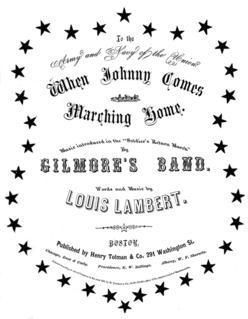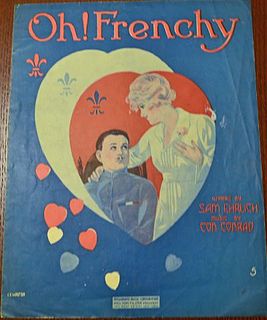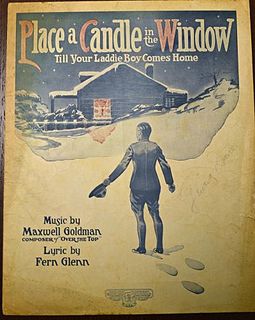
"When Johnny Comes Marching Home", sometimes "When Johnny Comes Marching Home Again", is a popular song from the American Civil War that expressed people's longing for the return of their friends and relatives who were fighting in the war.

"K-K-K-Katy" is a World War I-era song written by Canadian American composer Geoffrey O'Hara in 1917 and published in 1918. The sheet music advertised it as "The Sensational Stammering Song Success Sung by the Soldiers and Sailors", as well as "The Sensational New Stammering Song" The song was first played at a garden party fund-raiser for the Red Cross in Collins Bay on Lake Ontario. O'Hara was from Chatham, Ontario, and taught music at several universities.
Oley Speaks was an American composer and songwriter. His compositions include many religious songs, as well as his best-known success, "On the Road to Mandalay", which takes its lyrics from the poem "Mandalay" by Rudyard Kipling. The Canal Winchester Area Historical Society Museum has exhibits about the life of Oley Speaks, including original sheet music written by him.

Oh How I Wish I Could Sleep Until My Daddy Comes Home is a 1918 song written during World War I. It was performed by Henry Burr, with the music composed by Pete Wendling and the lyrics written by Sam M. Lewis and Joe Waterson. Based on sales estimates, the song hit a peak position of number three on the Top 100 US songs of its time.

"For Your Boy and My Boy" is a 1918 song composed by Egbert Van Alstyne, with lyrics written by Gus Kahn and published by Jerome H. Remick & Co. The song was performed by Al Jolson and later reached No. 4 on the top 100 US songs of 1918 with a cover by the Peerless Quartet.
David Kohn was an American songwriter and playwright. He was best known for songs involving World War I and Prohibition.

"When You Come Back" is a World War I song released in 1919.

"Over in Hero-Land" is a World War I era song released in 1918. Arthur Freed wrote the lyrics. Louis Silvers composed the music. Meyer Cohen Music of New York, New York published the song. It was written for voice and piano. The cover was designed by E. Pfeiffer. It features a drawing of a tank firing at soldiers. Below it is a picture of Lola Wentworth, who performed the song.

"Gee! What a Wonderful Time We'll Have When the Boys Come Home" is a World War I era song released in 1917. Lyrics and music were written by Mary Earl. The song was published by Shapiro, Bernstein & Co. of New York, New York. It was written for both voice and piano. The sheet music cover was designed by artist Albert Wilfred Barbelle. On the cover are soldiers marching down a city street. A skyline is behind them, and the lights spell out, "Welcome Home."

"When the 'Yanks' Come Marching Home" is a World War I era song released in 1917. William Jerome wrote the lyrics. Seymour Furth composed the music. It was published by A.J. Stansy Music Co. of New York City.

"Come On Papa" is a World War I era song released in 1918.

"Oh! Frenchy" is a World War I song written by Sam Ehrlich and composed by Con Conrad. It was published in New York, New York by Broadway Music corporation in 1918. The song was in the top 20 charts from September 1918 to March 1919 and was number 2 in October, December, and February. The sheet music cover features a soldier pictured in uniform with a woman in his heart.
"It Won't Be Long Before We're Home" is a World War I song in the style of a march. It was written by Paul Cunningham and composed by Joseph E. Howard. This song was published in 1918 by M. Witmark & Sons, in New York, NY.

Send Me Away With A Smile is a World War I song written by Louis Weslyn and composed by Al Piantadosi. The song was first published in 1917 by Al. Piantadosi & Co., Inc. in New York, NY. The sheet music cover depicts a woman waving to a soldier from a fenced yard with an inset photo of Rita Gould.

Set Aside Your Tears is a World War I song written and composed by Wolfe Gilbert, Malvin Franklin, and Anatole Friedland. The song was first published in 1917 by Jos. W. Stern & Co. in New York, NY. The sheet music cover depicts a woman waving to marching troops.
Wee Wee Marie is a World War I song written by Alfred Bryan & Joe McCarthy and composed by Fred Fisher. The song was first published in 1918 by McCarthy & Fisher, Inc., in New York, NY. The sheet music cover depicts a soldier and a woman facing each other speaking.
When I Come Back To You is a World War I song written and composed by William Tracey and Jack Stern. The song was first published in 1918 by Douglas & Newman Music in New York, NY.The sheet music cover depicts a soldier hugging a woman with the Liberty Bell in the background.

Place A Candle In the Window 'Till Your Laddie Boy Comes Home is a World War I song written by Fern Glenn and composed by Maxwell Goldman. The song was first published in 1918 by Buck & Lowney in New York, NY. The sheet music cover depicts a soldier returning to a snow covered house with a candle in the window.
When The Fleet Comes Sailing Home is a World War I song written by Carl M. Legg and composed by Jay Flanagan. The song was first published in 1918 by Songland Music in Brooklyn, NY. The sheet music cover depicts a mother, wife, and son in uniform waving at an arriving transport ship.













